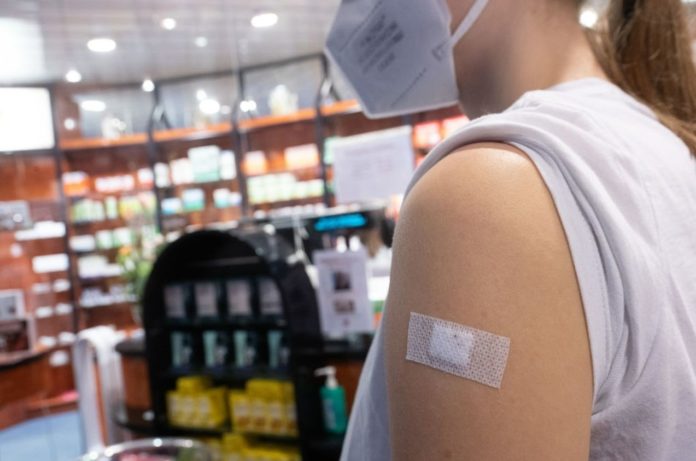SARS-CoV-2 spike protein can cause a huge cytokine storm in lung and liver epithelial cells. In a study published in the journal ACS Applied Bio Materials, researchers found that a herb can fight off this kind of cytokine storm.
Multi-organ failure, lung damage, and a poor prognosis for severe disease in COVID-19 patients are all linked to the interleukin (IL)-induced cytokine storm these patients had when they were infected with SARS-CoV-2.
SARS-CoV-2 interacts with human angiotensin-converting enzyme 2 (hACE2) receptors, causing a cytokine storm and potentially fatal systemic inflammatory responses.
Higher circulating cytokine levels and immune cell hyperactivation characterize the lethal inflammatory syndrome, which leads to secondary organ failure, including hepatic, pulmonary, and renal.
CUR, a dietary polyphenolic antioxidant molecule derived from the turmeric plant Curcuma longa L., is well-known for its powerful anti-inflammatory properties.
In this study, the authors looked at the anti-inflammatory effects of CURPS-NPs directed at a CoV2-SP-stimulated cytokine storm in lung and liver epithelial cells. They also looked at bulk-CUR (B-CUR) and PS-NPs, which are both anti-inflammatory. Further, the researchers explained how CUR blocked the signaling of nuclear factor B (NF-B) and the activation of mitogen-activated protein kinase (MAPK) that led to cytokine storms. This study was also done to see if CUR could help stop CoV2-SP from making the p42/44 MAPK, p65/NF-B, p38 MAPK, and nuclear p65/NF-B phosphorylation, and the release of growth factors, chemokines, and cytokines that are linked to lung and liver epithelial cell damage.
This work employed CUR (97 percent purity), pure biotinylated recombinant hACE2, and SARS-CoV-2 S recombinant glycoproteins. Furthermore, the liver Huh7.5 and lung A549 epithelial cells were obtained from the ATCC-recognized cell bank at the National Centre for Cell Sciences in Pune, India.
The PS-rich fraction of C. longa dried rhizomes was extracted and characterized. The CURPS-NPs were made using an emulsion solvent evaporation process with slight modifications. The epithelial cells were planted and cultured in a stock solution containing CoV2-SP.
An RNeasy mini kit was used to isolate total ribonucleic acid (RNA) from CoV2-SP-exposed epithelial cell pallets. The genes of CoV2-SP-exposed and unexposed epithelial cells were then tested using reverse transcription-quantitative polymerase chain reaction (RT-qPCR). An enzyme-linked immunosorbent test was used to evaluate the interaction between CoV2-SP and hACE2 (ELISA). Fluorescence-activated cell sorting (FACS) analysis, fluorescence microscopy, and the Alamar blue assay employing propidium iodide (PI) and Annexin V-FITC were used to assess cell viability.
Results revealed
The size of the CURPS-NPs was found to be within the nanomaterial range, and there was a continuous CUR release from the CUR–PS-NPs, according to the findings.
CUR–PS-NPs inhibited the release of chemokines such as IP10, MCP-1, and CXCL8, growth factors such as VEGF and C-C chemokine ligand 3 (CCL3), and cytokines such as IL-12, IL-6, and IL-1, all of which were linked to the impairment of CoV2-SP-triggered lung A549 and liver Huh7.5 epithelial cells.
CUR–PS-NPs inhibited more chemokines, cytokines, and growth factors in A549 and Huh7.5 cells than PS-NPs or B-CUR-treated cells. VEGF-A, CCL10, and CCL5 suppression was stronger in PS-NPs and B-CUR-treated A549 cells than in CUR–PS-NPs-treated cells. PS-NPs treatment alone had no significant inhibitory effects on the release of IL-8 and IL-6 in CoV2-SPs-triggered Huh7.5 and A549 cells.
CUR–PS-NPs-based therapeutics successfully reduced the interaction between CoV2-SP and the host ACE2. CURPS-NPs had a greater ability to block the interaction of CoV2-SP with human ACE2 than PS-NPs and B-CUR.
Conclusions
The study found that organic NPs of CUR derived from a PS-affluent fraction of turmeric rhizome, dubbed CURPS-NPs, show a high inhibitory capacity against CoV2-SP-induced cytokine storm in human lung A549 and liver Huh7.5 epithelial cells. Furthermore, CURPS-NPs inhibited the release of chemokines, growth factors, and cytokines in CoV2-SP-triggered epithelial cells via deactivating the NF-B/MAPK signaling pathway, which reduced epithelial cell injury.
Overall, the researchers concluded that CURPS-NPs have the potential to become a safe and effective COVID-19 therapy medication. However, more in vivo studies are needed to confirm CUR-PS-NPs’ ability to prevent CoV2-SP-induced cytokine storms in lung and liver epithelial cells.
Source: 10.1021/acsabm.1c00874
Image Credit: Getty
You were reading: A herb linked to lower risk of multi-organ failure, lung injury and poor prognosis in severe COVID-19 patients
